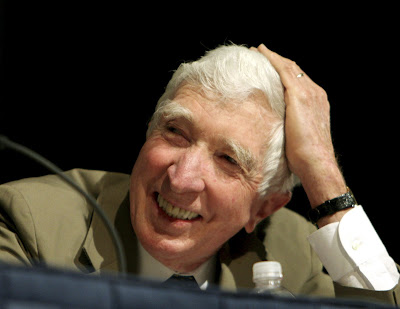I'll let the
heavy hitters of litland appraise the writing career of John Updike. What I'm thinking and feeling tonight, having learned of his death this afternoon, is personal in the way that Updike would understand. I never met him, but his words, his books, have been part of my life for a very long time.
When I was in high school and so taken with a few astonishing writers that I read their paperback books while walking the hot streets of my home town, Updike was one of them.
Pigeon Feathers, his second collection of stories, was the first volume of his I read. In those days, I got my paperbacks off the racks at the cigar store or at the supermarket, and a book like this was an amazing treasure. That Updike had been a small town boy from Pennsylvania (but from the eastern part of the state, while I was from the west) held a certain fascination, and his experience was a little ahead of mine and otherwise also different, but was a kind of beacon, as well as sharing important emotional notes. The story I remember the most, that was most important to me then, was "The Happiest I've Been." It added grace notes to my adolescence, and maybe more than that.
As a writer he was an example of style, and I learned a great deal from him then. (I also stored away in my memory for future use some lovemaking techniques from
Rabbit, Run.) For a couple of decades more he was a model and a measure. I remember reading the opening pages of
The Witches of Eastwick on a beach in his then hometown of Ipswich, Mass., and cursing because he still wrote better.
I remember his books in connection with people. When I think of his stories, and
Of the Farm, I remember Judy Dugan, and my first writing teacher, Harold Grutzmacher. The blue paperback copy of
Couples and Joni's admiration for the writing and nervousness about its content. Mary, who lived in Ipswich for awhile when Updike still did, and who I was visiting with on that beach. She ran into him once--he was buying an Electrolux. I bought several of his books-- hardcover, autographed-- at the Ipswich bookstore, that I wish I still had.
I read less of his fiction later on, mostly because I couldn't keep up with him. But always his reviews and essays when I came upon them, and I was struck today--and struck is the right word--when I couldn't think of anyone of my generation who could come close to the career he had--the number and quality of books, the breadth of what he wrote about. I doubt we would agree on much politically, but on other matters maybe more. I wrote him a heartfelt letter once at a crucial point in my "career," which he didn't answer. No matter. My admiration for his sentences and for how he talked about literature and his work is boundless.
Somewhere I have the exact quotes, but what I recall now are a couple of statements that remain with me as shared truths. One was to the effect that urban people think about each other, but small town people think about the universe. Another described his perfect reader as a small town boy who discovers his books in the public library--and of course his description is full of just the right sensory details. Which I guess more or less makes me the person he wrote all those books for.
And while I'm on this increasingly familiar subject, as my honored elders disappear from Earth, I only learned today of the death last August of
Ted Solotaroff. I met him twice. First when he was the young editor of the New American Review and came to Boston promoting it while I was an even younger editor at the Boston Phoenix. We talked enthusiastically of Gabriel Garcia Marquez, who was remaking our literary universe with
A Hundred Years of Solitude. I met him again in the 80s, when he wanted to edit my next book and publish my first book in paperback, only to have both projects promptly scuttled by others at his publishing house. The room always seemed full of possibilities in his presence.
I've still got his early memoir,
A Few Good Voices in My Head, which I recall as rueful and a cautionary tale. I'll have to look at it again. It was a piece of a more recent memoir published in a recent issue of
The Nation that clued me into his passing. Don't know how I missed that. He was an editorial hero who got crushed by the idiocy of the 80s, and pretty much said so.

